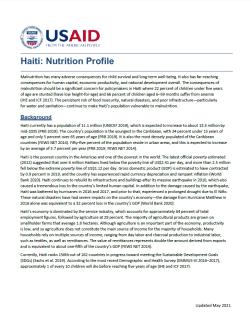Haiti currently has a population of 11.1 million (UNICEF 2019), which is expected to increase to about 13.3 million by mid-2035 (PRB 2019). The country’s population is the youngest in the Caribbean, with 34 percent under 15 years of age and only 5 percent over 65 years of age (PRB 2019). It is also the most densely populated of the Caribbean countries (FEWS NET 2014). Fifty-five percent of the population reside in urban areas, and this is expected to increase by an average of 3.7 percent per year (PRB 2019; FEWS NET 2014).
Haiti is the poorest country in the Americas and one of the poorest in the world. The latest official poverty estimated (2012) suggested that over 6 million Haitians lived below the poverty line of US$2.41 per day, and more than 2.5 million fell below the extreme poverty line of US$1.12 per day. Gross domestic product (GDP) is estimated to have contracted by 0.9 percent in 2019, and the country has experienced rapid currency depreciation and rampant inflation (World Bank 2020). Haiti continues to rebuild its infrastructure and buildings after its massive earthquake in 2010, which also caused a tremendous loss to the country’s limited human capital. In addition to the damage caused by the earthquake, Haiti was battered by hurricanes in 2016 and 2017, and prior to that, experienced a prolonged drought due to El Niño. These natural disasters have had severe impacts on the country’s economy—the damage from Hurricane Matthew in 2016 alone was equivalent to a 32 percent loss in the country’s GDP (World Bank 2020).
Haiti’s economy is dominated by the service industry, which accounts for approximately 64 percent of total employment figures, followed by agriculture at 29 percent. The majority of agricultural products are grown on smallholder farms that average 1.8 hectares. Although agriculture is an important part of the economy, productivity is low, and so agriculture does not constitute the main source of income for the majority of households. Many households rely on multiple sources of income, ranging from day labor and charcoal production to industrial labor, such as textiles, as well as remittances. The value of remittances represents double the amount derived from exports and is equivalent to about one-fifth of the country’s GDP (FEWS NET 2014).
Currently, Haiti ranks 156th out of 162 countries in progress toward meeting the Sustainable Development Goals (SDGs) (Sachs et al. 2019). According to the most recent Demographic and Health Survey (EMMUS-VI 2016–2017), approximately 1 of every 10 children will die before reaching five years of age (IHE and ICF 2017).

